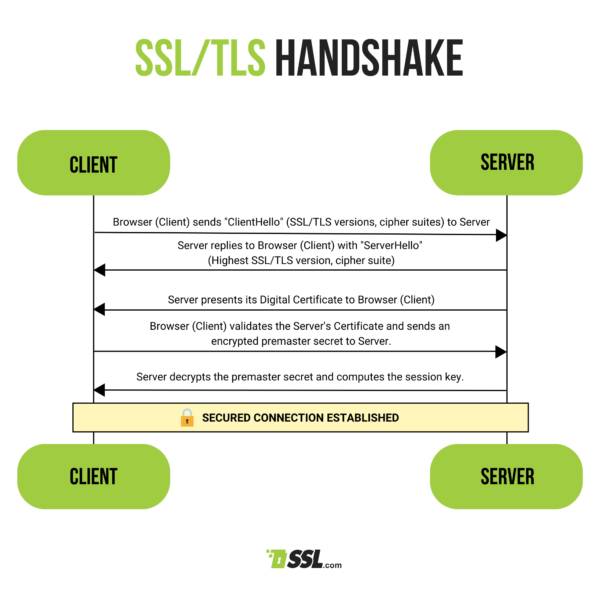Whenever we visit a website, make an online purchase, or check our email, data is transmitted back and forth between our devices and remote servers. This exchange of information over the internet raises an important question – how do we know our data is secure from prying eyes? The answer lies in encryption protocols like SSL/TLS.
SSL (Secure Sockets Layer) and its successor, TLS (Transport Layer Security), are security protocols that establish an encrypted link between a client (like your web browser) and a server (the website you are connecting to). This allows for secure transmission of data.
Let’s look closely at the SSL/TLS handshake and the steps that allow for safe internet connections.
An Overview of the SSL/TLS Handshake
The SSL/TLS handshake is a series of steps that allows two parties – typically a client and a server – to authenticate each other, agree on encryption standards, and establish a secure channel for transferring data.
It’s like a complex digital dance with sophisticated back-and-forth communication in milliseconds. To understand this handshake, let’s break it down step by step:

-
Introduction (ClientHello): Your browser sends a “ClientHello” message to the server when you request a secure website. This message contains essential information, including the SSL/TLS versions it supports and the cipher suites it can use.
-
Server’s Response (ServerHello): The server replies with a “ServerHello” message, including the highest SSL/TLS version and cipher suite both parties support.
-
Server’s Credentials: The server presents its digital certificate, verified by a Certificate Authority (CA) such as www.SSL.com, like an ID card providing its authenticity.
-
Client’s Verification and Key Generation: Your browser validates the server’s certificate. Once verified, it uses the server’s public key to encrypt a ‘premaster secret,’ a unique session key, and sends it back to the server.
-
Establishing a Secure Connection: The server decrypts the premaster secret with its private key. The server and client then compute the session key, which will be used for symmetric encryption of all communication.
Key Components of the SSL/TLS Handshake
Now that we’ve outlined the basic SSL/TLS handshake steps, let’s dig into the core concepts and technology that make this handshake possible:
Asymmetric Encryption
This refers to using a pair of keys – one public and one private – for encryption. Data encrypted with the public key can only be decrypted with the private key. This enables secure transmission of data.
Symmetric Encryption
This uses a single shared key for encrypting and decrypting data. Symmetric encryption is faster than asymmetric encryption. The SSL/TLS handshake uses asymmetric encryption to securely share the symmetric session key between parties.
Digital Certificates
These electronic documents bind a public key to an entity like a website or organization. They enable secure authentication on the internet. Digital certificates are issued by Certificate Authorities (CAs) such as www.SSL.com.
Cipher Suites
A cipher suite is a set of algorithms that define the cryptographic parameters for an SSL/TLS session. This includes key exchange methods, encryption ciphers, and hash functions.
Session Keys
The client and server generate temporary symmetric keys unique to each session, called session keys. All data transmitted during the session is encrypted using these keys.
Mutual TLS
Mutual TLS (mTLS) is a mode where both the client and server authenticate each other using digital certificates. This provides enhanced security compared to standard one-way TLS authentication. The client must have its own certificate and key pair in mTLS.
Putting it All Together
The SSL/TLS handshake brings together these technologies to create a securely encrypted session:
-
Digital certificates authenticate the server’s identity.
-
Asymmetric encryption allows secure exchange of the symmetric session key.
-
Cipher suites provide encryption algorithms.
-
Session keys encrypt the data flow between parties.
Why the SSL/TLS Handshake Matters
A seamless SSL/TLS handshake enables the encrypted data transmission that secures our digital world. It allows safe online commerce, communication, and connectivity by:
-
Verifying you are connected to the authentic site and not an impersonator
-
Encrypting all data exchanged during the session.
-
Ensuring no third party can read or modify the information as it travels across the internet
Without the SSL/TLS handshake, our sensitive information would be exposed online.
Final Thoughts
Despite its complexity, the SSL/TLS handshake aims to keep our online interactions safe. Every time we make an online purchase, log into our email, or engage in private conversations, it’s there.
The SSL/TLS handshake also adapts to the security needs of each session by altering its security parameters to fit the situation. But it’s crucial to be careful, stay updated with the latest SSL/TLS versions, and select robust cipher suites.


